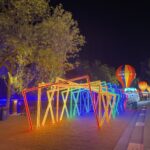Fengjing Ancient Town is located in the southwest corner of Shanghai and is a typical Jiangnan water town. As early as more than 2,000 years ago, people lived in Fengjing Ancient Town. The boundary river in the town was the boundary river between the State of Wu and the State of Yue in the Spring and Autumn Period. Due to straddling the two realms of Wu and Yue, Fengjing Ancient Town is known as ‘a famous town of Wu and Yue’.
The ancient town has crisscrossing rivers and as many as 52 bridges. Among them, Zhihe Bridge built in the Yuan Dynasty has a history of nearly 700 years. Compared with other popular Jiangnan water towns, Fengjing does not have so many tourists. You can leisurely enjoy the scenery of small bridges and flowing water here. The ancient town has two main streets. One is a street with the southern section called South Street, the middle section called Middle Street, and the northern section called North Street (although there are three names in sections, they are actually a continuous street). The other is Heping Street. The two streets intersect at Fengjing Three Bridges, forming a ‘T’ shape. Fengjing Three Bridges is the center of the ancient town. At the confluence of two rivers, you can see Qingfeng Bridge, Zhuhang Bridge, and Beifeng Bridge at the same time. Fengjing is the birthplace of Jinshan peasant paintings. You can enjoy paintings full of local flavor at the Jinshan Peasant Painting Exhibition Center in Shengtang Lane on South Street. There are many painting galleries and former residences of famous painters in the ancient town. In Ding Cong Cartoon Exhibition Hall on North Street, there are furniture used by Mr. Ding. On the second floor, you can see satirical cartoons that vividly depict characters. In Lv Jiren’s Painting Gallery on Heping Street, you can see the paintings of Lv Jiren, a classmate of Chen Yifei. Cheng Shifa’s former residence has many Chinese watercolor paintings by Mr. Cheng. Generally, tourists enter from the main entrance in the south of the ancient town and walk to South Street. Then they start to stroll around the ancient town slowly along the river. Walking northeast from South Street and passing Zhihe Bridge, you will reach Middle Street. At the beginning of Middle Street, you can see the boundary mark of Wu and Yue. There is a boundary stone standing there. The inconspicuous small river in front is the former boundary between Wu and Yue. Continuing to walk northeast, after passing Fengjing Three Bridges is North Street. On North Street, you can visit Shiwang Temple with red walls built in the Ming Dynasty, Ding Cong Cartoon Exhibition Hall, etc. On South Street, Middle Street, and North Street, you will also pass long corridors with roofed sheds. There are several such long corridors in the ancient town. They are antique. They can block the sun on sunny days and rain on rainy days. Treading on the bluestone road and returning to the place of Fengjing Three Bridges, then go to visit another street, Heping Street. First, visit Sanbai Garden (Hundred Basket Museum, Hundred Lantern Museum, Hundred Trades Museum). Next to it is Lv Jiren’s Painting Gallery. Walking a little southeast, the former site of the People’s Commune is worth seeing. There are old-fashioned thermos flasks and telephones from that era. There is a red sun painted on the wall. Further ahead is the ancient Fengjing stage facing the street on one side and the river on the other. During peak tourist seasons and holidays, there are free traditional drama performances on the stage. Sitting in a window-side seat in Chenshe Teahouse opposite the stage, sipping tea and listening to the opera is very pleasant.Visit the ancestral home of Cheng Shifa at the end of the street, and then cross the bridge to the production street on the opposite bank of the river, where you can find the former site of a modern fire-fighting institution – the East District Fire Administration. At the head of the South Street in Fengjing Ancient Town, there is a boat dock where you can take a boat ride to experience the charm of the water town.

The first recommendation for local cuisine in the ancient town is Ding’s Pig’s Feet. Next to the Zhihe Bridge on South Street, there is a workshop dedicated to Ding’s Pig’s Feet, showcasing the development and production techniques of this local delicacy.









